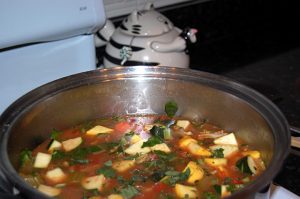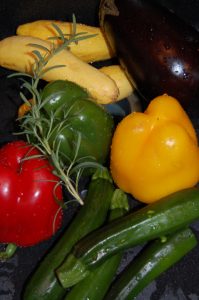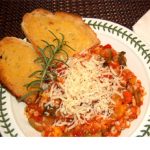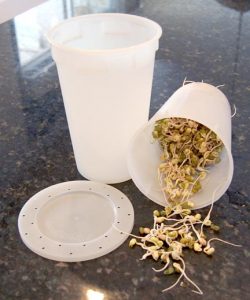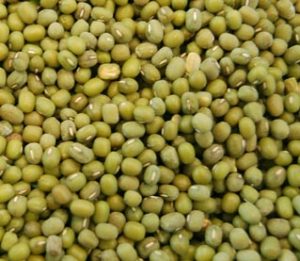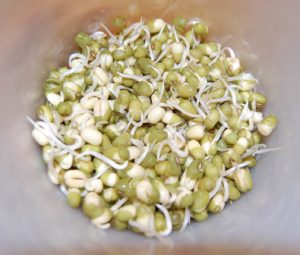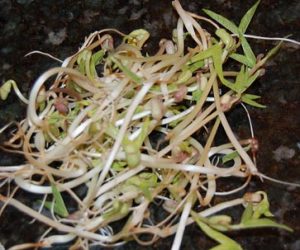I really love a hearty soup. Living in Colorado, our winters can begin in early October and last pretty much into May. I’ve come up with a lot of soup recipes over the years. I think of soups as perfect food: you can have you veggies, protein and carbs all mixed together in one warm, thick, hearty, delicious and satisfying meal. Soups can be very forgiving: you don’t have to follow soup recipes like a scientific equation. If you like the ingredient, it will play nice in the pot. As a mother, I’ve also found that you can pack extra nutrition into soups and fussy eaters won’t even know it’s there. Nutrition espionage at its finest.
I remember being in Kindergarten and Mrs. Rogers, our teacher, told us a story about stone soup. Her version was (and I’m not quoting her accurately here) there was a homeless man camping in the woods. He had no food and no one in the village was charitable enough to give him any. Some children came upon him in the woods. He had a campfire going and a pot of water boiling over the flames. Nowadays this story would never be told — who in their right mind would want their kids visiting with a hobo in the woods? Anyway, the kids asked him what he was making. He said “stone soup” —and he tossed a stone into the boiling water. He said the soup was normally extremely delicious, but this one was missing something. A few carrots maybe. One of the kids ran home and brought him carrots. He tasted the water and said, “I bet an onion would make this taste great.” So another kid brought him an onion. He tasted the soup and said, “something’s missing, I think some celery would make this taste even better…” and so on until the kids had brought him many ingredients and he finally had this masterful soup. Well, I just thought he was the cleverest hobo that ever lived! And the story has stuck in my mind to this day. My Kitchen Sink Soup always reminds me of this story.
I wasn’t planning to make soup this week. It has been sunny, glorious and at least 70° every day. Not exactly soup weather. But I had a few odd bits of vegetables left in the fridge from my excursion to Heavenly Harvest Produce a couple of weeks ago. I also had some leftover cooked veggies. None of them added up to a full serving. Tie breaker: I bought some pork neck bones for my dog as an experiment. She is on a raw meat, species-appropriate diet, and I’m always looking for something new and economical for her to eat. I hadn’t added too many different bones to her diet, preferring to stick with the ever-safe natural chicken backs from WholeFoods and an occasional pork rib. The neck bones looked meaty and the bones didn’t look too thick and hard. After opening the package I found only one I was willing to give to my dog, so I thought the rest would make a nice broth. That’s when I decided that soup was definitely going on the menu.
Like my Kitchen Sink Salad, the name comes from my tossing an odd assortment of vegetables in the sink for rinsing. I also consider the soup consisting of “everything but the kitchen sink.” Gotta keep an open mind. I start out with my typical basic soup base: a chopped onion, 2-3 ribs of chopped celery, a few cloves of chopped garlic and 2-3 chopped carrots. Sometimes I sauté them in super-healthy coconut oil, but this time I opted for extra virgin olive oil. I sauté these in a dutch oven until the onion starts to approach translucency. At this point I added the pork neck bones, browned them just a little bit, and then added 8 cups of chicken broth. Since the pork was raw going in and I wasn’t going anywhere, I turned the heat way down and let it simmer for an hour plus. I added some salt and pepper at some point. When it looked “right,” I turned off the heat, moved the pork bones to a plate and left the pot on the stovetop to cool down. Once the bones cooled off, I stripped the meat off, put it in a separate bowl and placed it, covered, in the fridge. My son is a vegetarian and so to make life easier, I make one big pot of soup (he doesn’t mind broths, he just won’t eat meat) and keep the actual meat bits separate for my own dining pleasure.
When I had gathered all the other ingredients I wanted to put in my soup, I turned the burner back on, starting chopping veggies and adding them to the broth as I went along. Once the pot was full, I let them simmer for about 30 minutes. I had some teensy alphabet pasta in the pantry and threw it into the broth to soften. When we were ready to have dinner, I put some of the meat bits into bowls and we served ourselves the hot soup. We grated some parmesan cheese on top and toasted and buttered some artisan bread for dunking. My absolute favorite is the rosemary bread sold at WholeFoods — not only is it delicious, but when you toast it the fragrance of rosemary fills the kitchen. It also makes heavenly croutons. My African Greys and our pet rat also got—and loved—some soup for dinner. What was left was given to the chickens who quickly cleaned their plate. There’s nothing so universal as good, healthy food.
This soup freezes really well too!
YOUR Kitchen Sink Soup
Ingredients
- 2-3 TB Olive oil
Soup base
- 2-3 carrots chopped
- 2-3 stalks of celery chopped
- 1 cup onion chopped
- garlic to taste
- 4-8 cups stock (poultry, meat or veggie); Better Than Bouillon will do if you don't have stock. Amount depends on how much you want to make
Soup Ingredients
- Whatever you like or need to use up! Raw or cooked vegetables, meats; herbs such as oregano, thyme, parsley, bay; rice, pasta, beans or barley.
- Season to taste. Since you may be using cooked veggies, keep in mind they already have been seasoned
- A little grated parmesan on top is great!
Instructions
- Sauté the soup base vegetables in the olive oil; once they soften a bit (10 mins?), add the stock.
- Add the other ingredients of your choice and cook for 20-30 minutes. Cooked rice or pasta should go in last so they don't get mushy.

